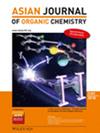基于分子内S/Se⋅⋅⋅ONO2硫键的超分子结构设计
IF 2.8
4区 化学
Q1 CHEMISTRY, ORGANIC
引用次数: 0
摘要
以2 -硝基环(杂)芳烃为原料,与硫代或硒氰酸钾反应合成了一系列2 -硝基二氮杂)芳烃。这些化合物通过核磁共振光谱、高分辨率质谱和X射线晶体学进行了表征。在所得晶体结构中,硫基氰酸酯部分的硫原子与硝基之间存在很强的Ch⋅⋅ONO2 (Ch=S, Se)硫键。这些相互作用阻止了硝基的旋转,从而稳定了在扭曲的平面几何结构中得到的2 -硝基二氮杂环芳烃。此外,在一些结构中还观察到分子间的Ch⋅⋅⋅N硫键。使用基于第一性原理和DFT方法的方法研究了分子内和分子间的相互作用。Qtaim, igmh, elf, nbo)。结果表明,4 -硝基- 5 -硫氰基-邻苯二甲酸酯(2a)和4 -硝基- 5 -硒氰基-邻苯二甲酸酯(2b)具有与芳烃共结晶的超分子结构,得到了4个新的共晶(2⋅PhMe, 2⋅o - XylH, 2⋅p - XylH和2⋅⋅1.5(p - XylH))。这些共晶的X射线衍射研究表明,在所有情况下,邻苯二腈分子(2a或2b)和相应的碳氢化合物通过π⋅⋅⋅⋅⋅⋅⋅⋅⋅⋅⋅⋅⋅⋅⋅⋅O/N ChBs结合它们形成最终的超分子结构。本文章由计算机程序翻译,如有差异,请以英文原文为准。
Design of Supramolecular Tectons via Intramolecular S/Se⋅⋅⋅ONO2 Chalcogen Bonding
A series of 2‐nitrochalcogenocyanato(hetero)arenes were synthesized by the reaction of 2‐nitrohalo(hetero)arenes with potassium thio‐ or selenocyanate. These compounds were characterized by NMR spectroscopy, high‐resolution mass spectrometry, and X‐ray crystallography. In the obtained crystal structures, strong intramolecular Ch⋅⋅⋅ONO2 (Ch=S, Se) chalcogen bonds between the chalcogen atom of the chalcogenocyanate moiety and the nitro group were revealed. These interactions prevent rotation of the nitro group, and thus stabilize the obtained 2‐nitrochalcogenocyanato(hetero)arenes in a distorted planar geometry. In addition, intermolecular Ch⋅⋅⋅N chalcogen bonds were observed in some structures. Both intra‐ and intermolecular interactions were studied using methods based on first‐principles and DFT approaches (e. g. QTAIM, IGMH, ELF, NBO). Two of the synthesized chalcogenocyanates namely, 4‐nitro‐5‐thiocyanatophthalonitrile (2a) and 4‐nitro‐5‐selenocyanatophthalonitrile (2b) were identified as promising supramolecular tectons for cocrystallizations with aromatic hydrocarbons, and four new cocrystals (2 a⋅PhMe, 2 a⋅o‐XylH, 2 a⋅p‐XylH, and 2 b⋅1.5(p‐XylH)) were obtained. X‐ray diffraction studies of these cocrystals demonstrated that in all cases molecules of the phthalonitrile (2 a or 2 b) and the corresponding hydrocarbon are packed into infinity columnar stacks via π⋅⋅⋅π interactions, whereas intermolecular Ch⋅⋅⋅O/N ChBs bound them to form the final supramolecular architecture.
求助全文
通过发布文献求助,成功后即可免费获取论文全文。
去求助
来源期刊

Asian Journal of Organic Chemistry
CHEMISTRY, ORGANIC-
CiteScore
4.70
自引率
3.70%
发文量
372
期刊介绍:
Organic chemistry is the fundamental science that stands at the heart of chemistry, biology, and materials science. Research in these areas is vigorous and truly international, with three major regions making almost equal contributions: America, Europe and Asia. Asia now has its own top international organic chemistry journal—the Asian Journal of Organic Chemistry (AsianJOC)
The AsianJOC is designed to be a top-ranked international research journal and publishes primary research as well as critical secondary information from authors across the world. The journal covers organic chemistry in its entirety. Authors and readers come from academia, the chemical industry, and government laboratories.
 求助内容:
求助内容: 应助结果提醒方式:
应助结果提醒方式:


